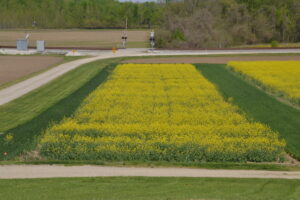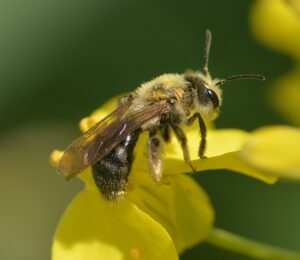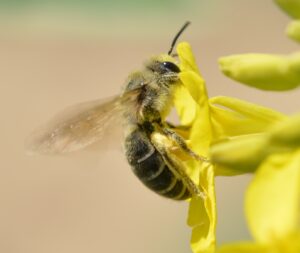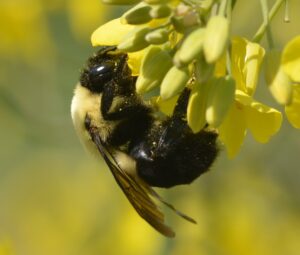In watermelon systems in Indiana, cover crops are extensively used with the primary function of acting as a wind-break to protect the seedlings when they are planted in May. Due to the nature of the landscape and the soil type (e.g., open areas with sandy soils), seedlings are exposed to physical damage caused by sandblasting. Therefore, cereal rye or wheat is seeded in the fall, which protects vulnerable transplants in the spring. These cover crops are interspersed with rows of watermelons, generally at a ratio of three rows of watermelons for a row of cover crop (Figure 1).
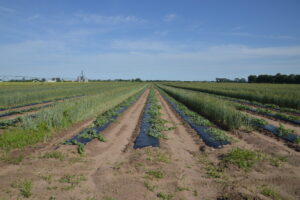
Figure 1. Commercial watermelon field with 3 rows of watermelon interspersed with 1 row of rye (June 2022). (Photo by Zeus Mateos.)
However, rye and wheat cover crops have been reported to act as alternative host plants (i.e., acting as a “green bridge”) for pests, particularly spider mites, which can move into the crop and cause economic damage. Many growers time miticide applications to coincide with rye or wheat senescence in mid-summer. Additionally, grass cover crops do not provide resources to support beneficial insects (i.e., natural enemies and pollinators). As a result, we have begun testing alternative cover crop options, focusing on flowering plants that minimize spillover of pests like mites and provide supplemental pollen and nectar for bees used to pollinate seedless watermelon.
We have started a trial at three Purdue Agricultural Centers across Indiana (TPAC, SWPAC, and SEPAC) to explore the benefits of non-rye cover crops. Our project aims to enhance populations of natural enemies and wild bees to improve ecosystem services: pest regulation and pollination. We are using economically available flowering cover crops, which can be used in combination with or replace the typically used cereal rye. At each location, we established eight treatment plots with five replicates. Treatments include i) cereal rye, ii) crimson clover (Figure 2), iii) hairy vetch, iv) cereal rye + crimson clover, v) cereal rye + hairy vetch, vi) buckwheat, vii) mustard, and viii) bare ground. We established rye, crimson clover, and vetch in Fall 2022, while buckwheat (spotlighted in VCH issue 718) and mustard were established in Spring 2023. We chose cover crops with different bloom times to test whether they distract from crop pollination, which is a major concern of growers. For instance, crimson clover blooms before watermelon, mustard (sowed in spring) and buckwheat bloom at the same (but for a short period) time as watermelon, and hairy vetch blooms during the whole season, as does watermelon.

Figure 2. Crimson clover plot at SEPAC (May 2023), surrounding beds awaiting watermelon transplants (Photo by Joel Wahlman).
We have begun investigating which bees are attracted to these plots, including canola (mustard), which was widely blooming around the state last month (Figure 3). A total of 3,872 bees (Figure 4) were recorded from the surveys we conducted in these plots over three days! Honey bees were the most abundant visitors, with ~58% of all records, indicating that canola is an excellent forage plant for these managed pollinators. Wild bees were also abundant in these plots (42% of visitors), which were dominated by mining bees (Figure 5a), plasterer bees (Figure 5b), and queen bumble bees (Figure 5c). We also documented sweat bees, carpenter bees, green-metallic sweat bees, and mason bees.
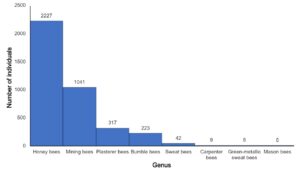
Figure 4. Total number of bees visiting canola flowers at SPWAC in April 2023 in 630 min surveying time.
These data show how important it is to establish cover crops at the right time. Given how early in the season that canola blooms, it would not interfere with watermelon pollination, which comes much later in June. However, early flowering cover crops may also not benefit watermelon pollination since many of the spring-active pollinators, such as mining bees, that forage on canola are no longer active by mid-summer when watermelon is in bloom.
Establishing cover crops in the field can be challenging due to unpredictable weather conditions. Among the cover crops we seeded in the fall, rye established best. Crimson clover and hairy vetch also established very well at all locations, except for crimson clover at TPAC (located in Northern Indiana), perhaps due to the colder winter temperatures. We seeded mustard in the fall as well, but due to a late sowing, it didn’t survive frost over the winter, and we had to re-seed in the spring at all three locations, which is now delaying its spring bloom period. Buckwheat, although it was seeded in April, also suffered severe frost damage due to the unexpected low temperatures late in the month.
Throughout the remainder of the growing season, we will be sampling all plots for wind damage, pests, pollinators, natural enemies active in biocontrol, and watermelon yields. We want to thank Dennis Nowaskie (SWPAC), Chloe Richard (Meigs/TPAC), Joel Wahlman (SEPAC) and their crews for establishing and managing the plots and Kenneth Eck for allowing us to survey his canola plots at SWPAC.
If you are interested in participating in cover crop research on your vegetable farm, please get in touch with Zeus Mateos (zmateosf@purdue.edu)!
